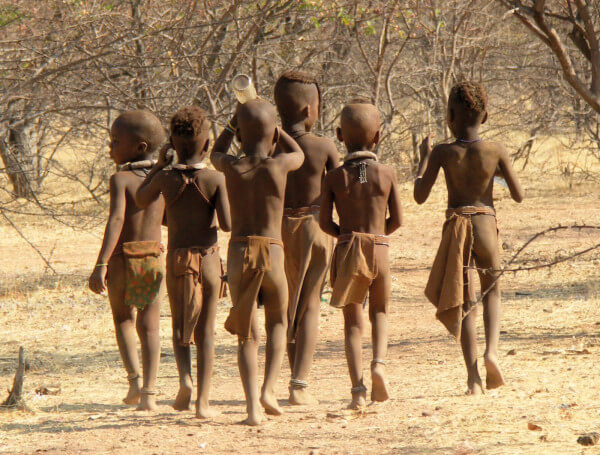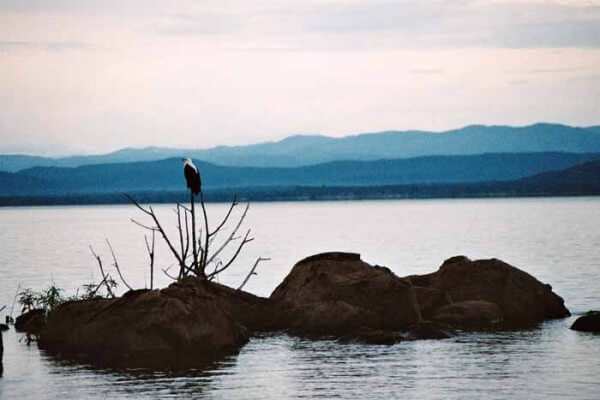Chobe National Park was established in 1968, and covers over 11,700 square kilometres of floodplains, swamps and woodland. Located in northern Botswana, the Park is home to one of the biggest game populations in all of Africa. It is the third biggest reserve in the country, following the Central Kalahari Game Reserve and the Gemsbok National Park. It is the country’s first national park and houses a massive variety of incredible wildlife.
The Chobe River
The Chobe Riverfront is renowned for its big herds of elephants and Cape Buffalo, which gather at the river to drink during the more arid months of the year. During this season, you might have the chance to witness hundreds of elephants at once during an afternoon game drive. As these magnificent creatures make their way to the river to drink, bathe and play they often will block the roads, providing fantastic close-up photographic opportunities. When you travel around the edges of the river, you will have a chance to spot up to fifteen varied animal species, including waterbuck, lechwe, puku, giraffe, kudu, roan, sable, impala, warthog, bushbuck, monkeys and baboons. Along with these, you will also be able to see the accompanying predators, such as lion, leopard, hyena and jackal.
A river cruise on the Chobe River is the perfect way to do some relaxing game viewing, during which you will have the chance to observe nature up close. Some of the animals you might see during this include hippo, crocodile and a wide variety of water birds. The park contains more than 460 bird species, making it one of the leading African venues for bird tours. The Chobe River rises in the northern highlands of Angola and journeys huge distances before arriving in Botswana. Whilst the River makes its way through the Kalahari Basin, its southern bank rises from the floodplains to create a flat stretch of vast grasslands and woodland. Majority of the soils in the Park are either sand or clay, characterised by a wide range of pans and waterholes.
Chobe National Park
Chobe National Park is renowned for its large lion concentration. Prides can be spotted all over the reserve, and are unique in their behaviour. Other big cats in the Park include cheetah and leopard. The cheetahs tend to inhabit the open grasslands and floodplains, whilst the thick scrub, rocky outcrops and riverine forests are inhabited by the leopards. The original human dwellers of this region were the San bushmen, nomadic hunter-gatherers who were continually traveling from place to place in search of food sources, water and wild animals. Presently you will be able to view San painting inside the rocky hills of the reserve.
The Park houses around 50,000 elephants which might be the biggest elephant population in Africa. It is also part of the biggest continuous surviving elephant population, which has consistently increased since 1990 from just a couple of thousand. Elephants dwelling in this Park are Kalahari elephants, which are the biggest of all known elephant species. They are characterised by rather fragile ivory and short tusks that are due to the lack of calcium in the soils. During the raining seasons, these beautiful animals begin a 200 kilometre migration to the southeast area of the reserve. With so much to offer in fauna, flora and scenery, any trip to Botswana would not be complete without a visit to the spectacular Chobe National Park.
Chobe Elephants
Chobe is probably best known for its elephants – Kalahari elephants – the largest elephants known to mankind. Their ivory tusks are rather brittle and short which is due to the lack of calcium in the soil. There are an estimated70 000 elephants in the park, so game spotting is rife here. In fact during an afternoon game drive you may besurrounded by elephants as they move across the main road on their way to the river, trumpeting and communicating with each other. Their majestic size is overwhelming and they are surprisingly not shy of humans.
You will find them along the banks of the Chobe river in the dry season where there is still water, but in the wet season they migrate 200km to the southeast of the park. The elephants sometimes migrate as far as Zimbabwe in search of water and lush green vegetation.
During the rainy season, the elephants migrate 200km to the southern regions of the park, reaching into Zimbabwe.
Wildlife in Chobe National Park
Chobe National Park is one of Botswana and Africa’s smallest and oldest national parks, offering the largest concentration of game. It features lush floodplains, dense wooldands (including mahogany, teak and other sought after hard woods) largely reduced by the elephant population.
Chobe National Park Wildlife is best viewed from May to October offering an incredible diversity of wildlife in the dry season from birdlife, giraffe, sable, cape buffalo, tsetsebe. The floodplains are the only area where puku antelope can be seen, including an array of birdlife including ibis, stork, duck and waterfowl.
The park offers camping sites where you can get a real feel for the wild side of this famous National Park. Guided mobile safaris allow for insights into the natural world around you as your experienced guides opens your eyes to the wildlife that survive in this region. Animals roam the park freely, so you are asked to take caution and not leave food out at night, ensure your litter is correctly disposed of and listen to your guide during the day tours.
There are various day trips available from 1 to 3 hours to full day game drives. Relaxing boat cruises along the Chobe River allow you to spot wildlife from a safe distance! There are also full day photographic mobile safari tripswhere you can test and improve your photography skills, taking home wonderful memories.
After a long day of wildlife sightseeing, one looks forward to a place to unwind and wash off the African dust. Chobe offers private lodges as well as unique tented camps. They boast eco tourism so visitors are educated about how to ensure they keep the natural environment intact by saving water and being a responsible tourist. Excellent service is offered by the staff ensuring a comfortable stay, and of course while you unwind over sundowners there are other travellers you can meet and make new friends with.





0 Comments